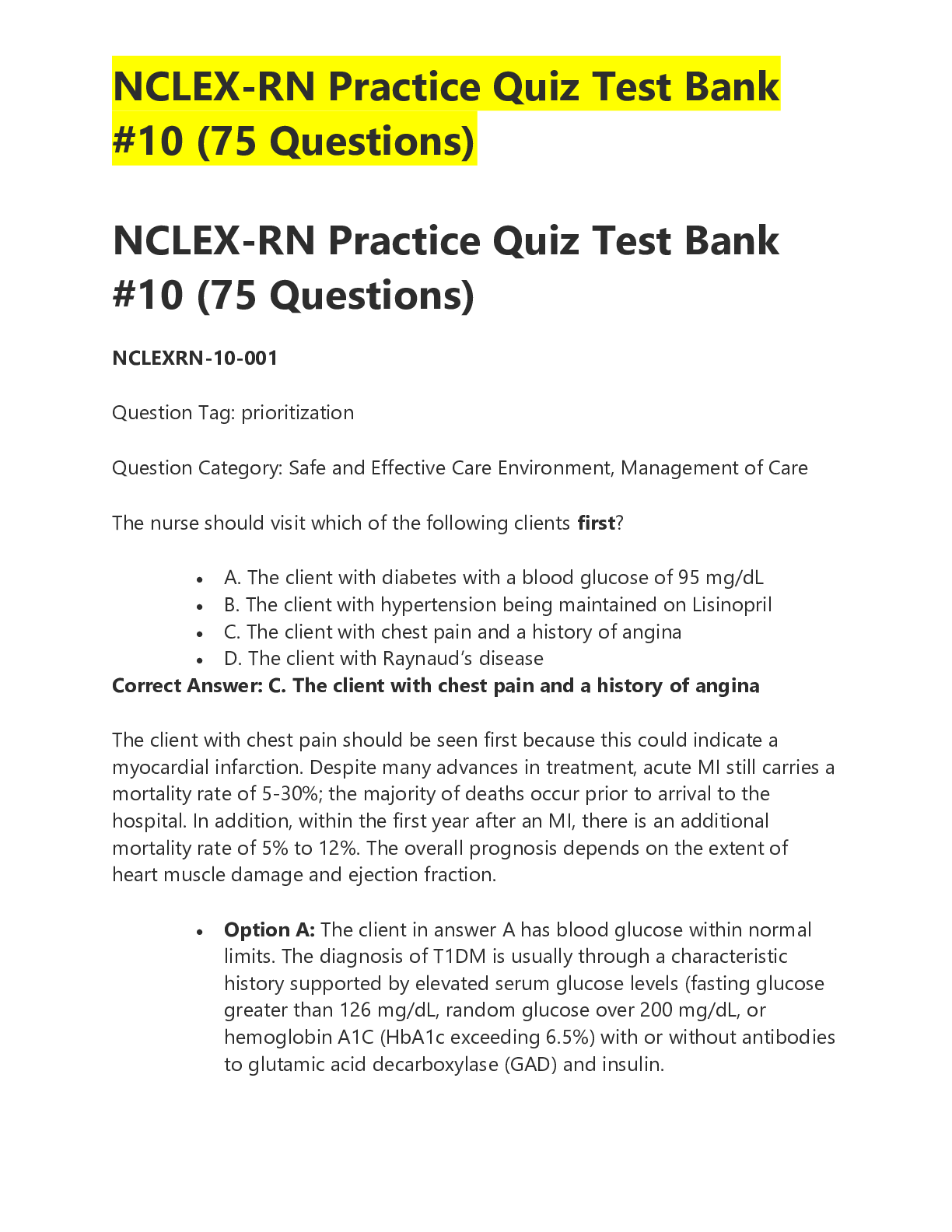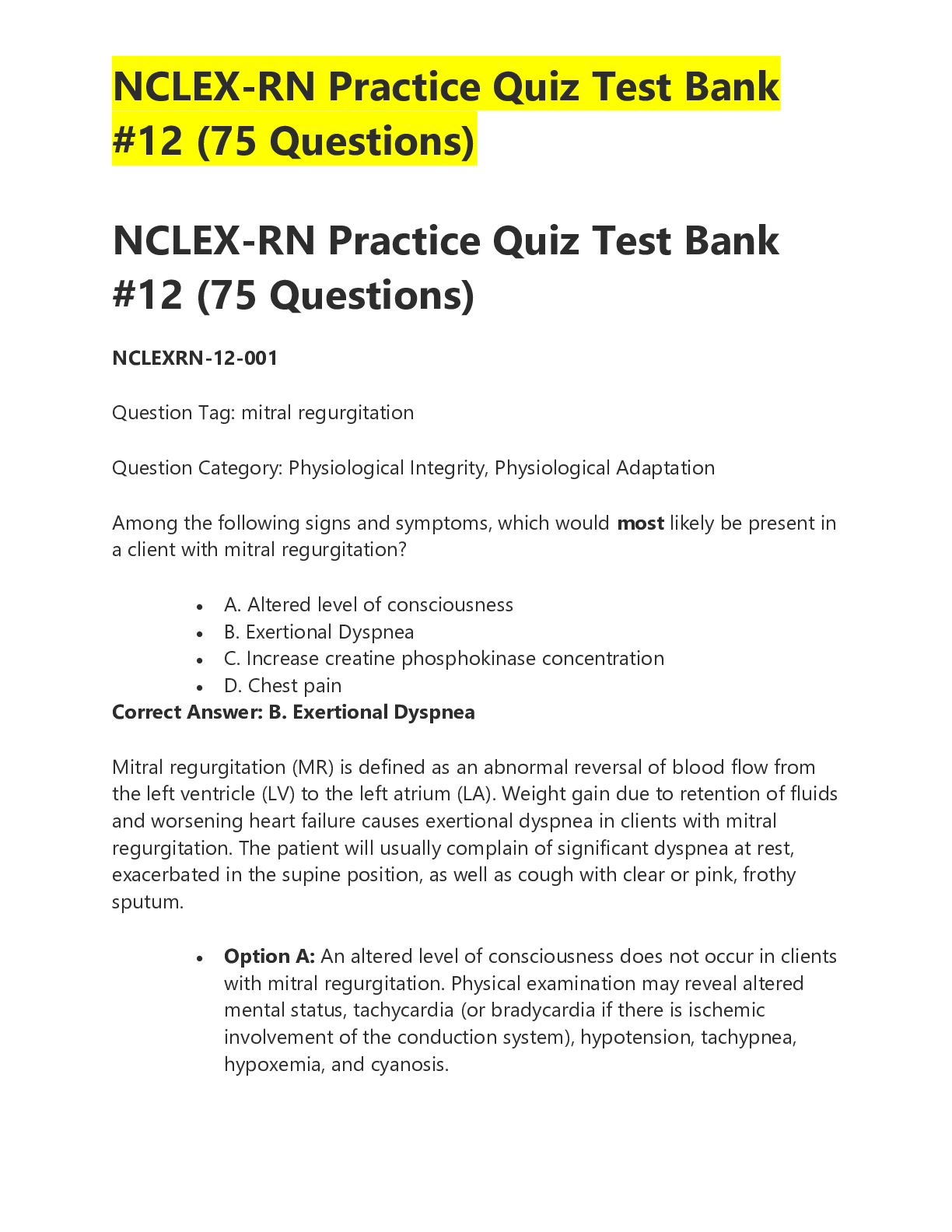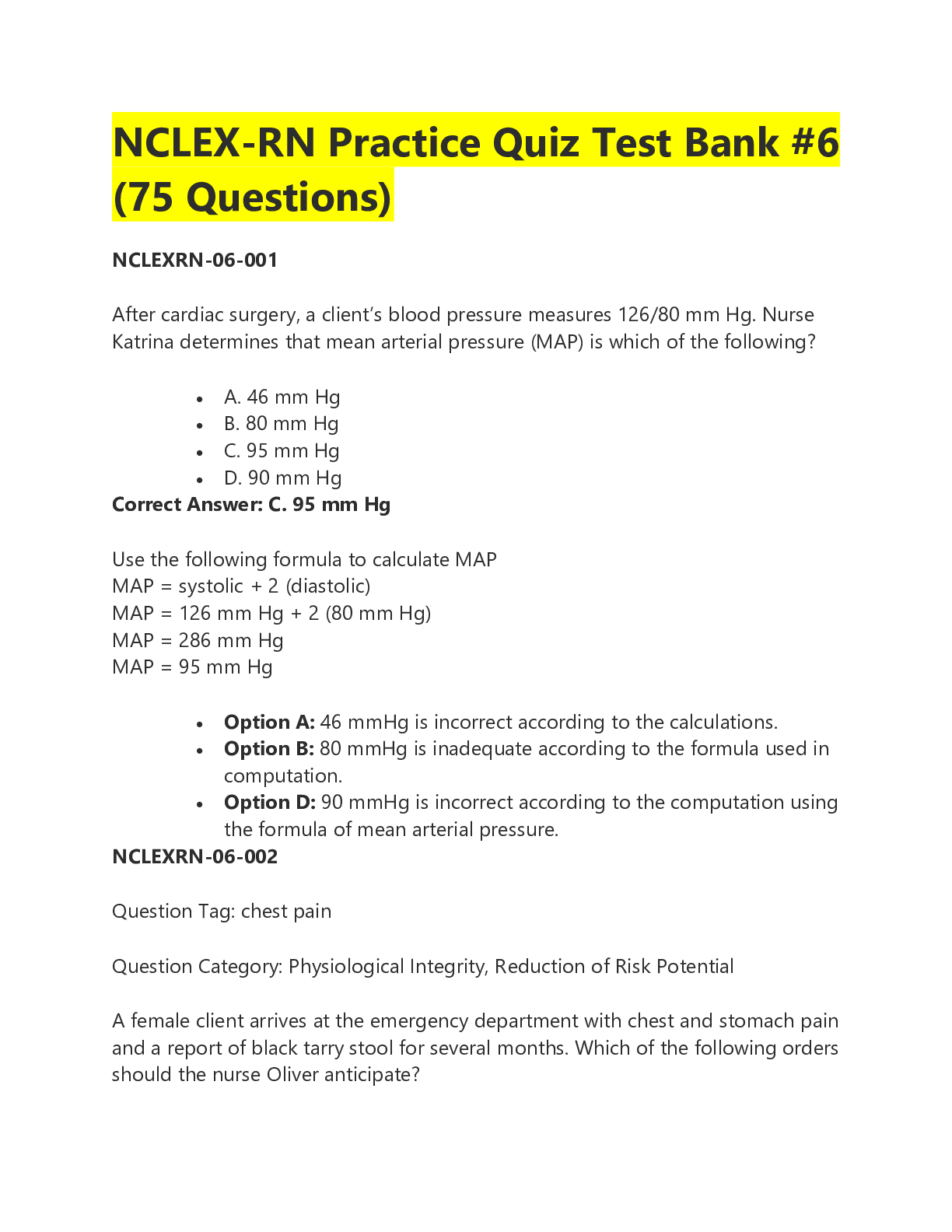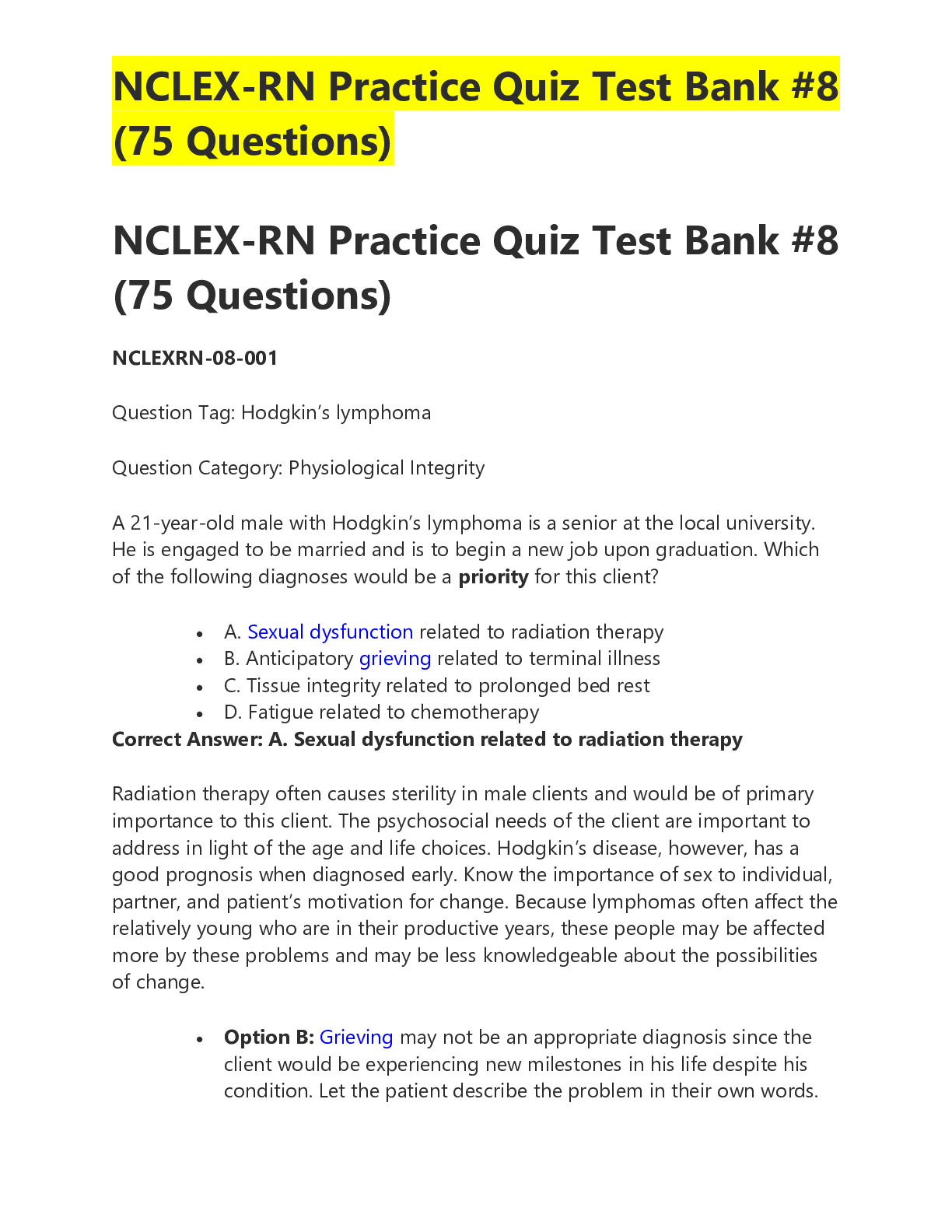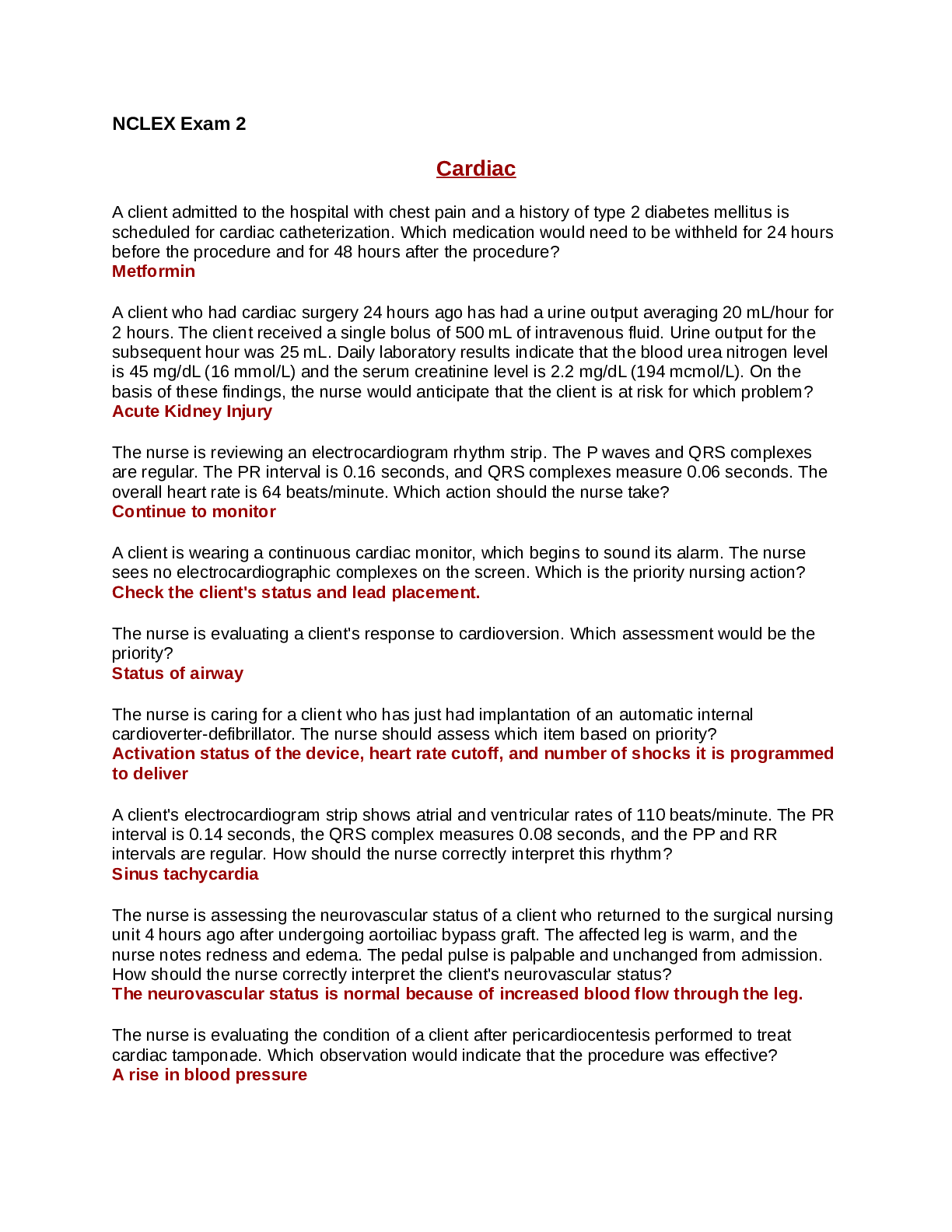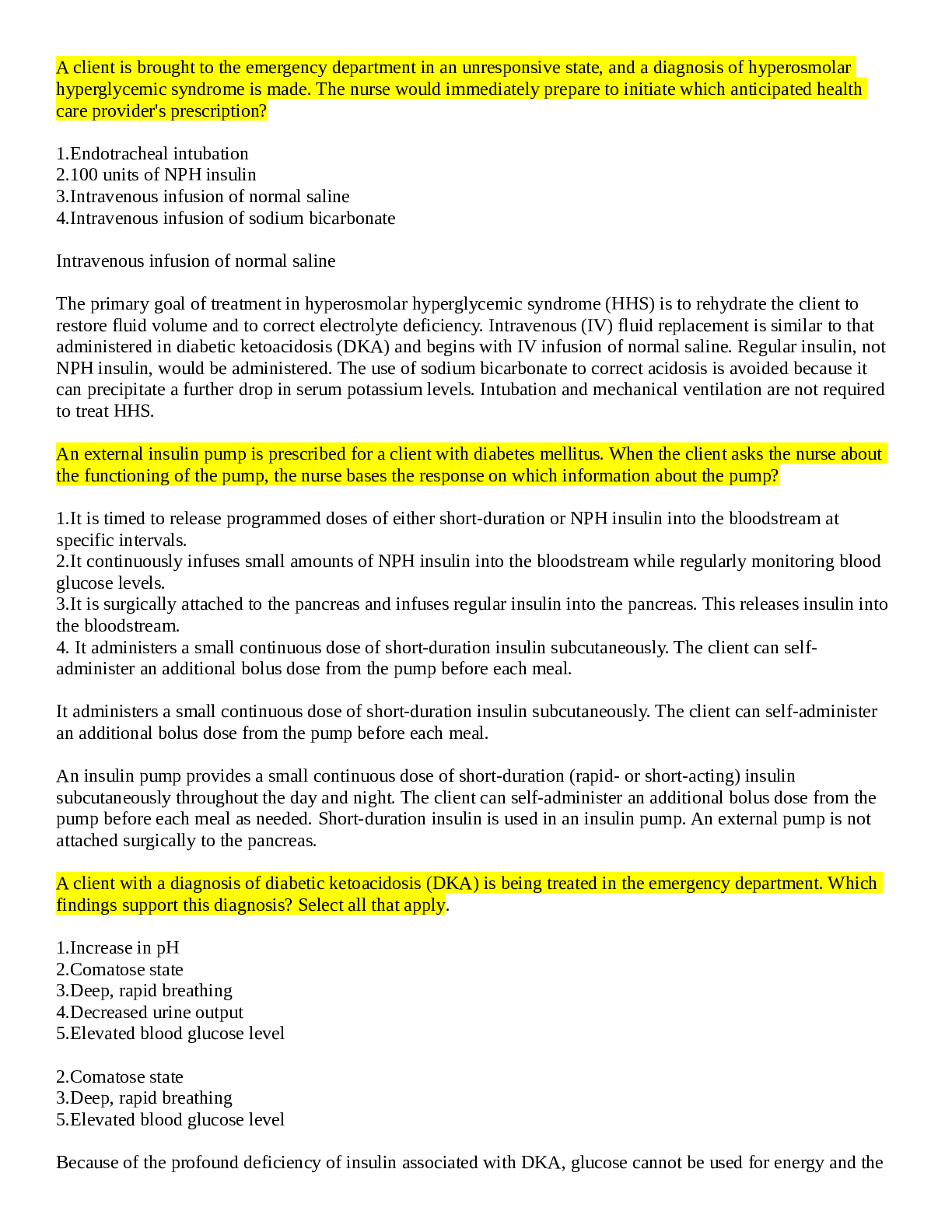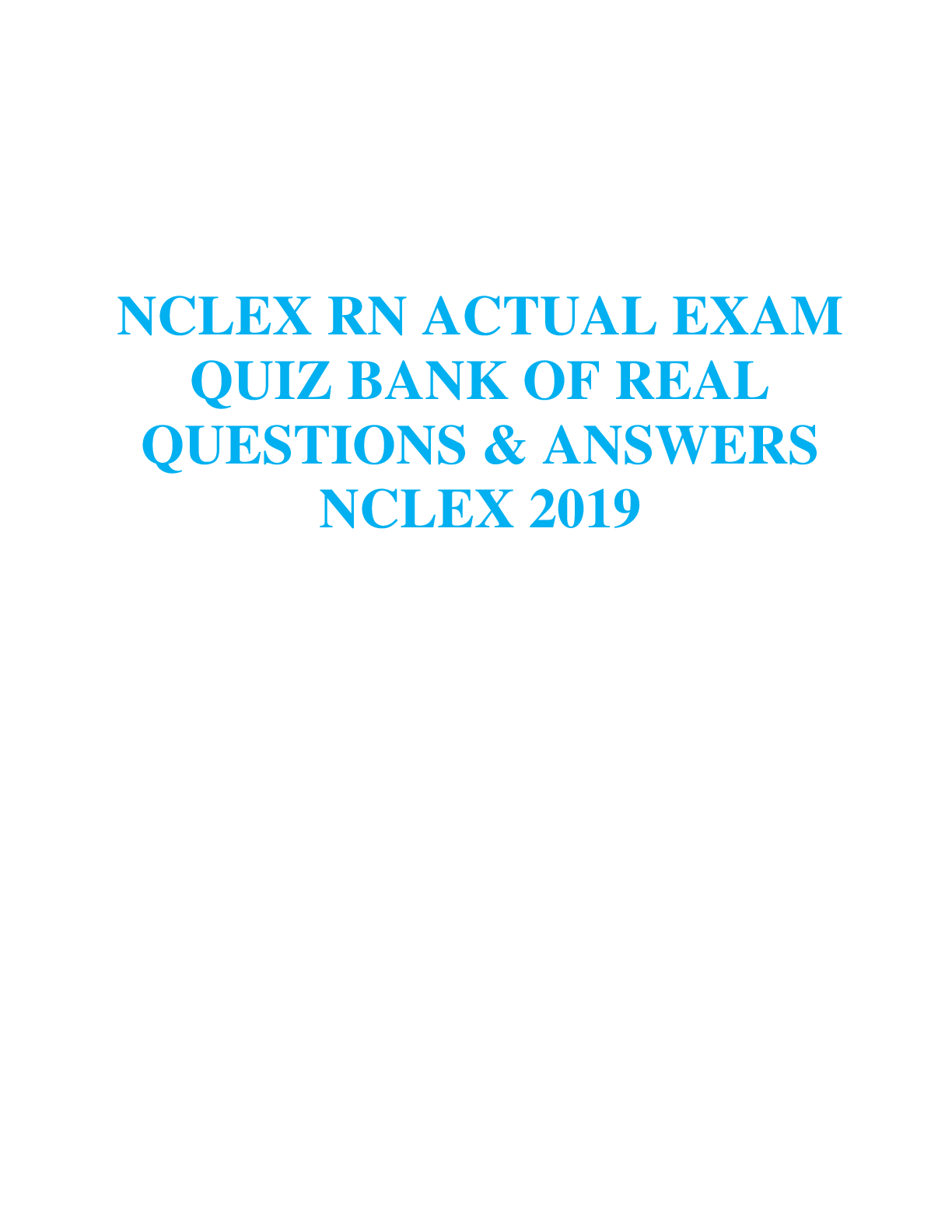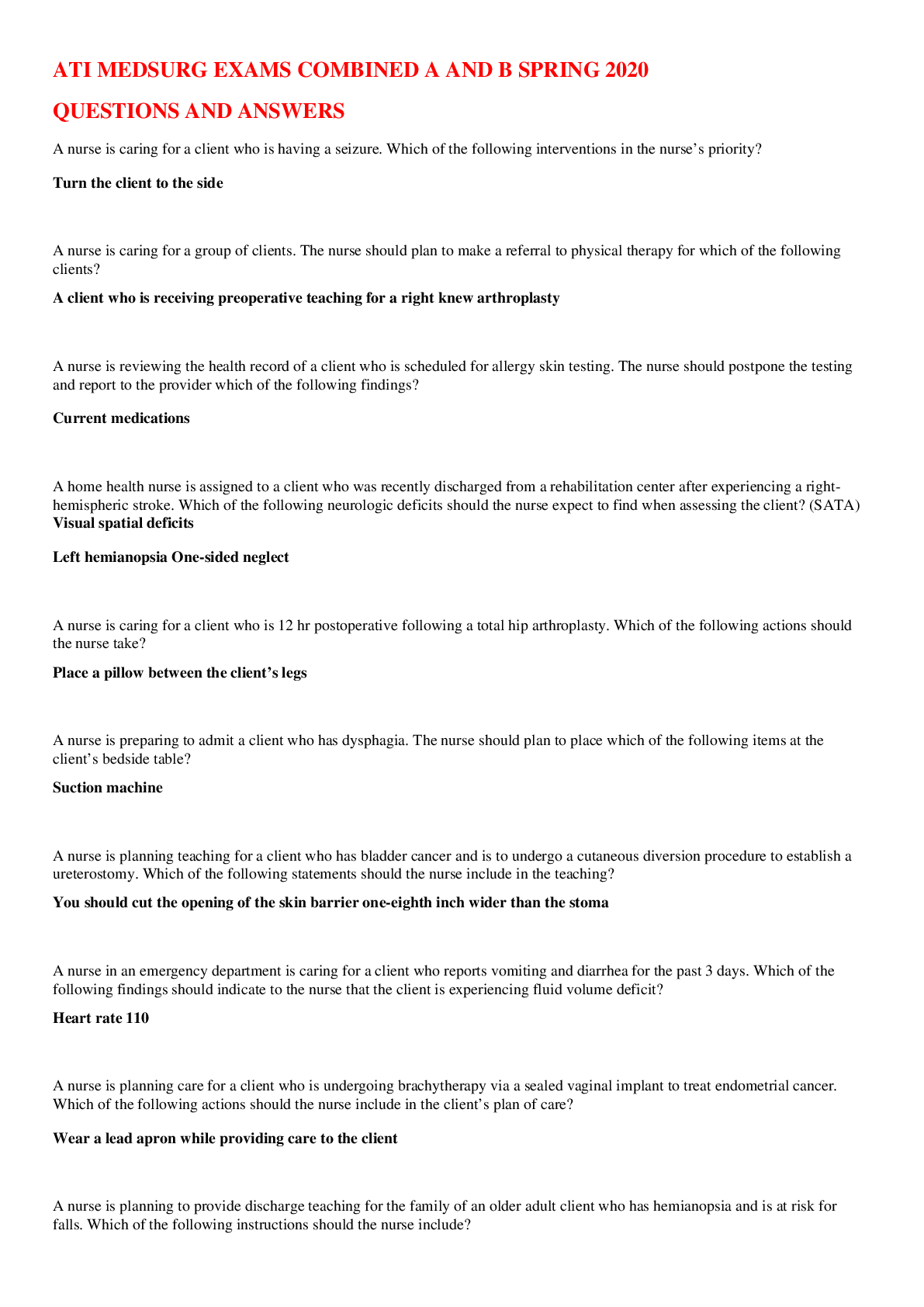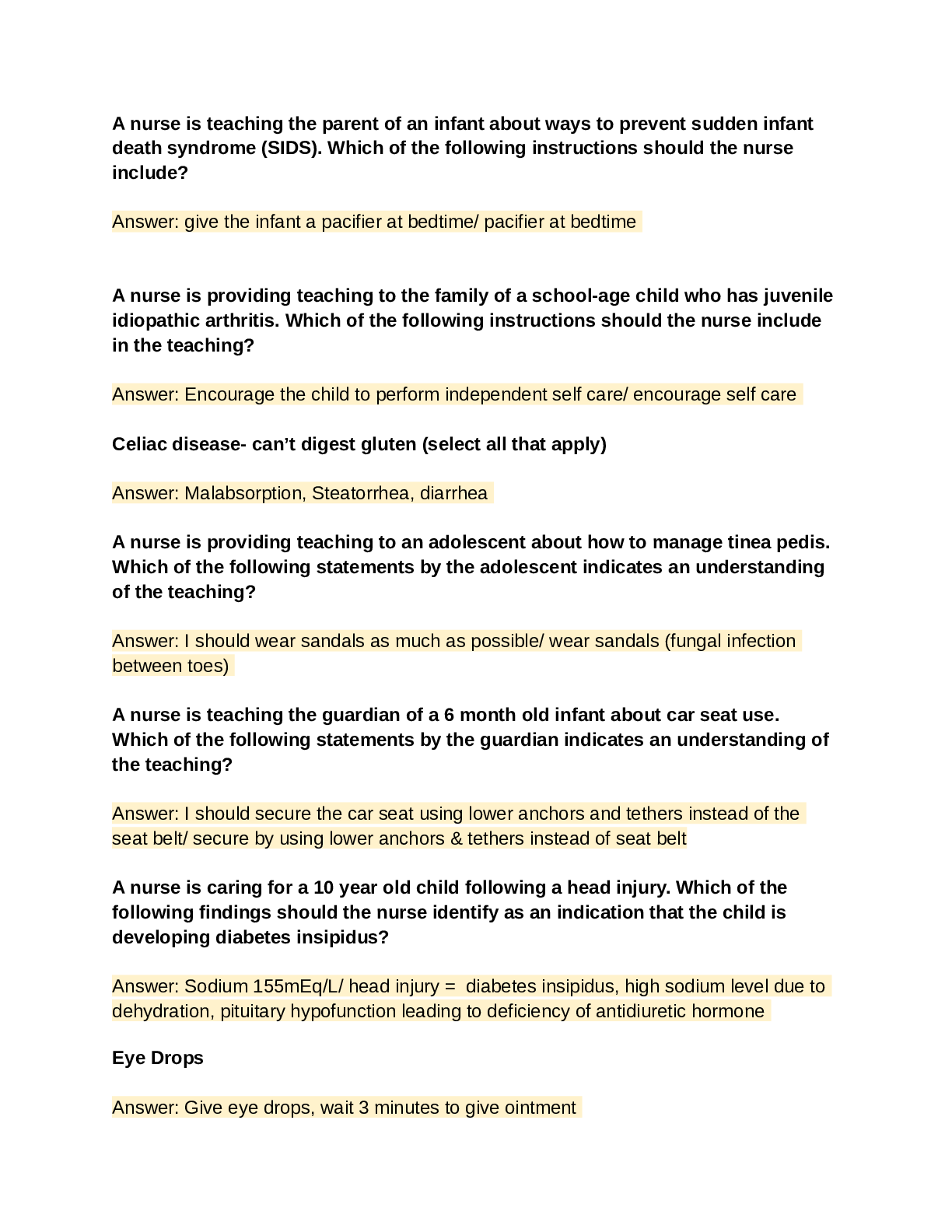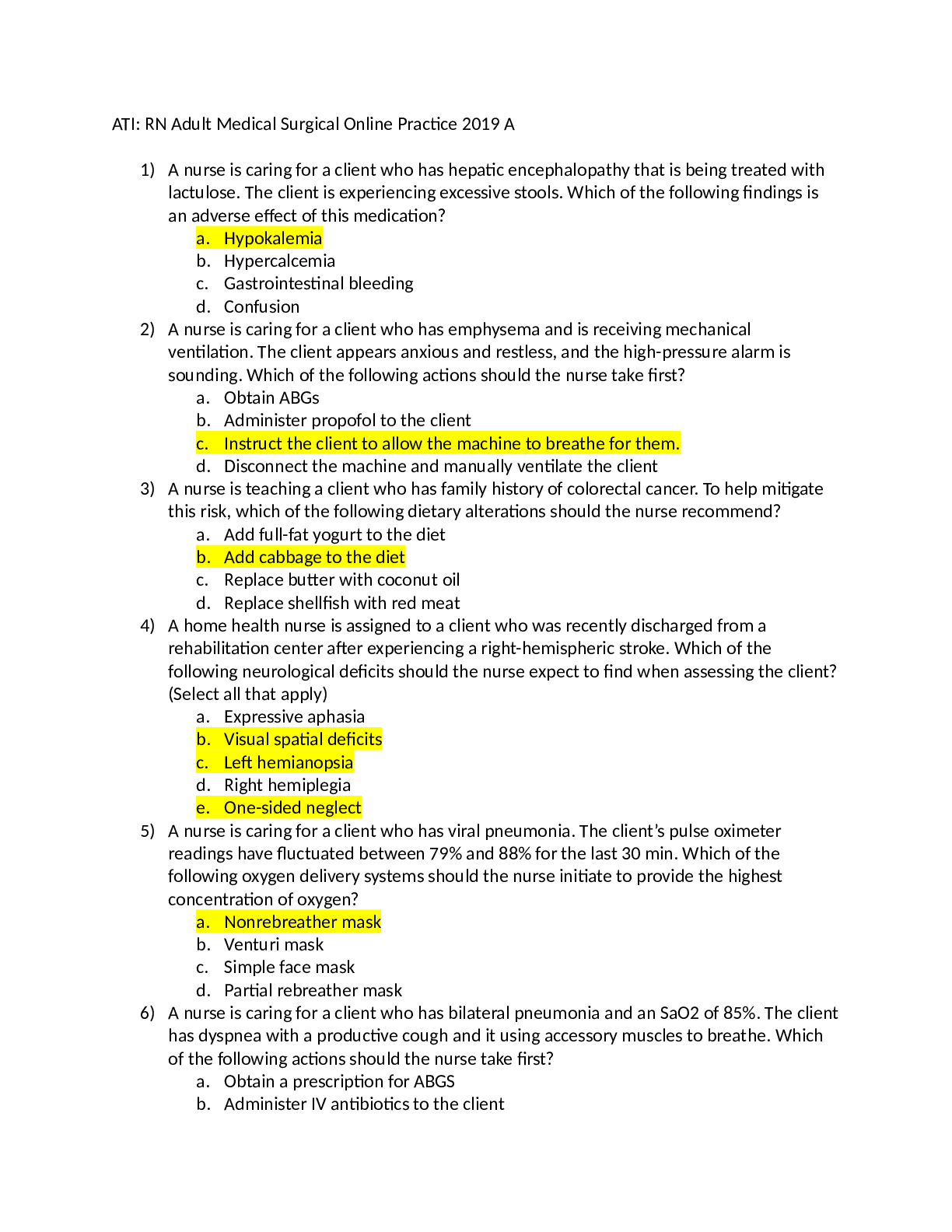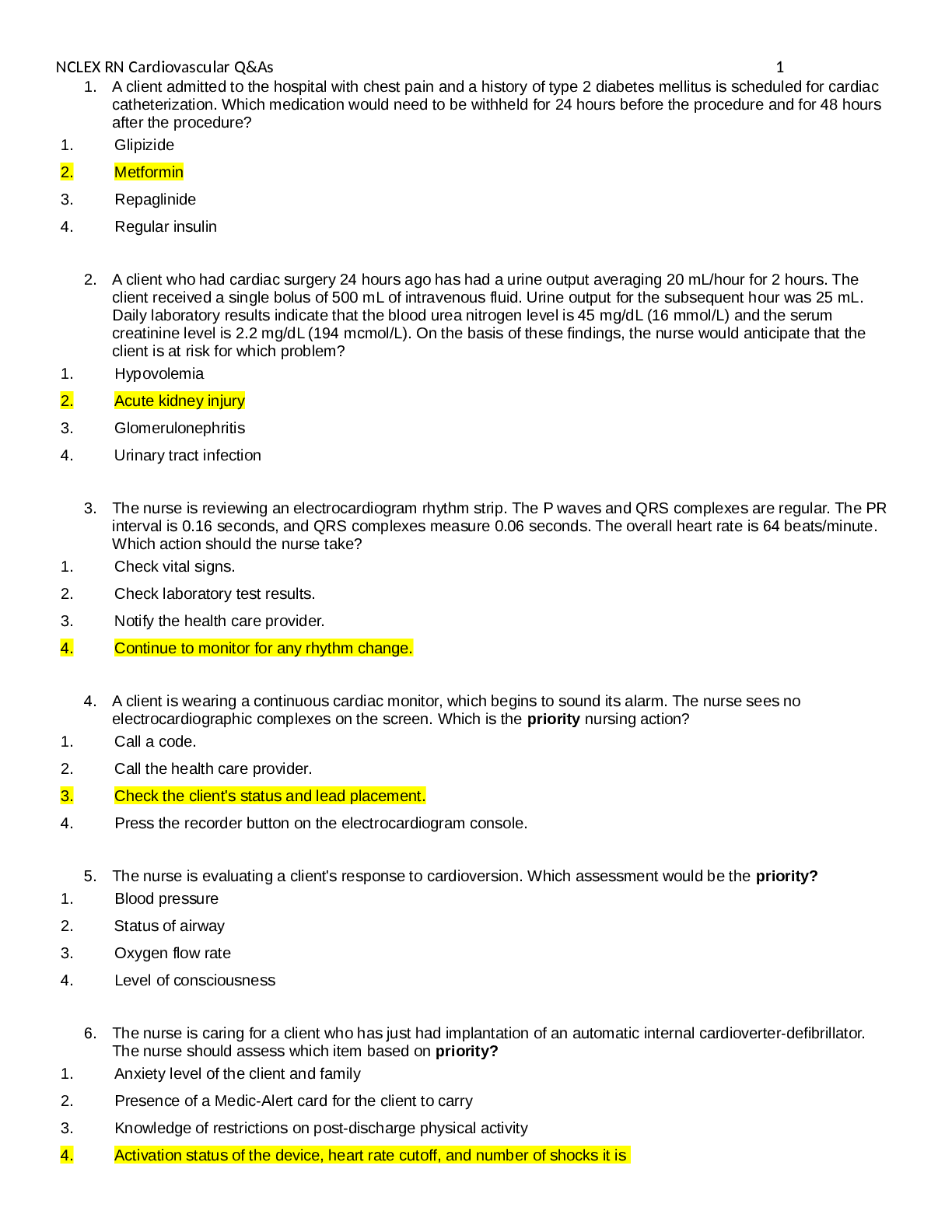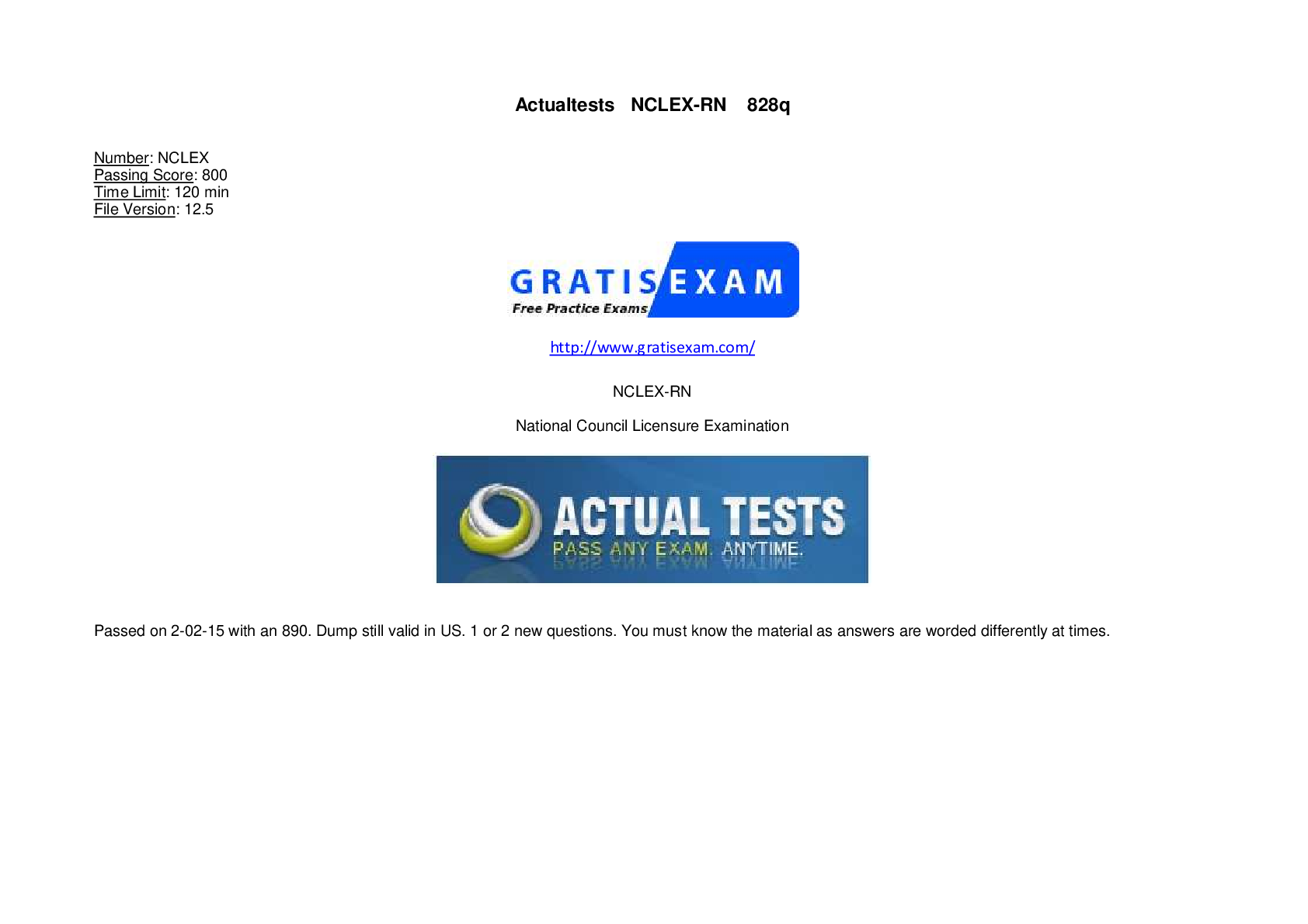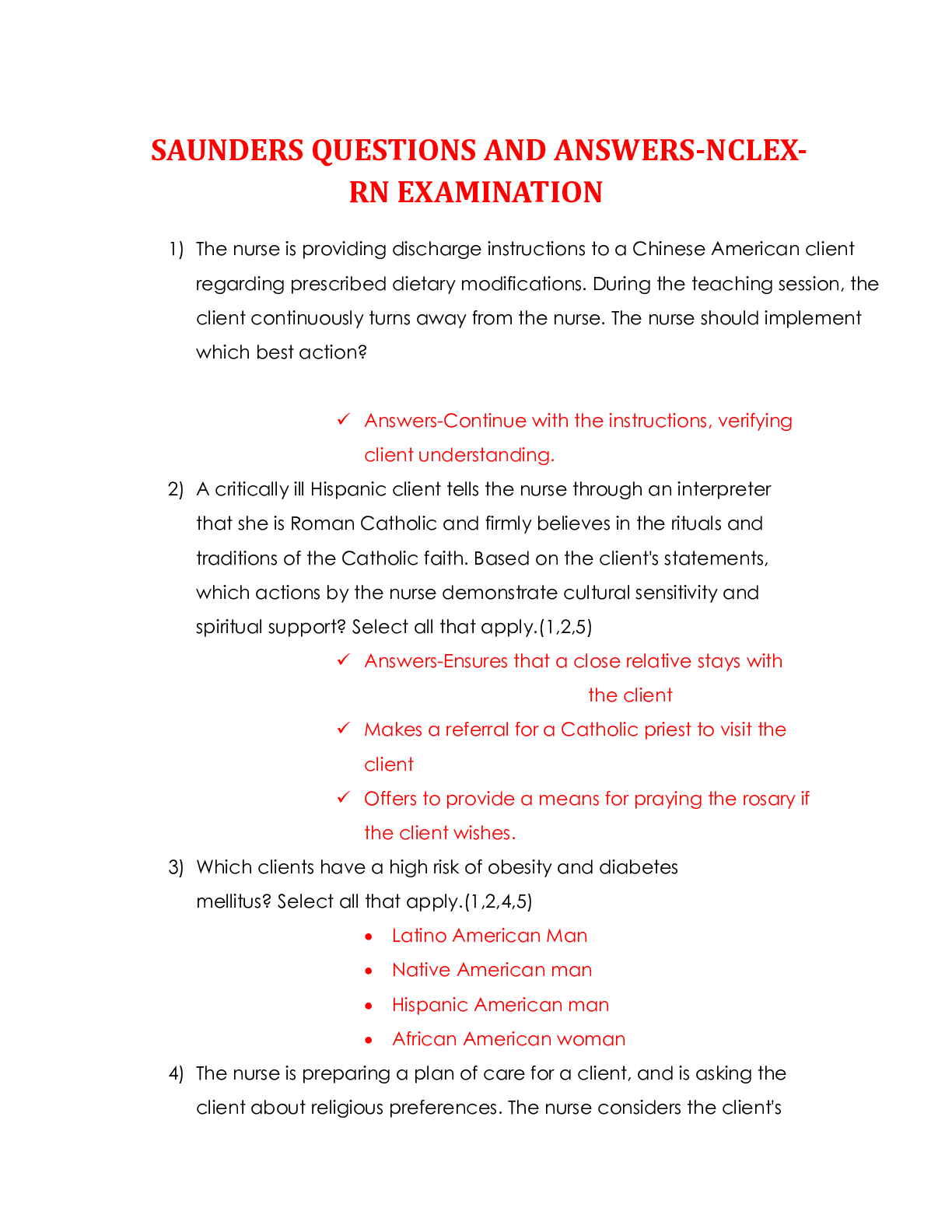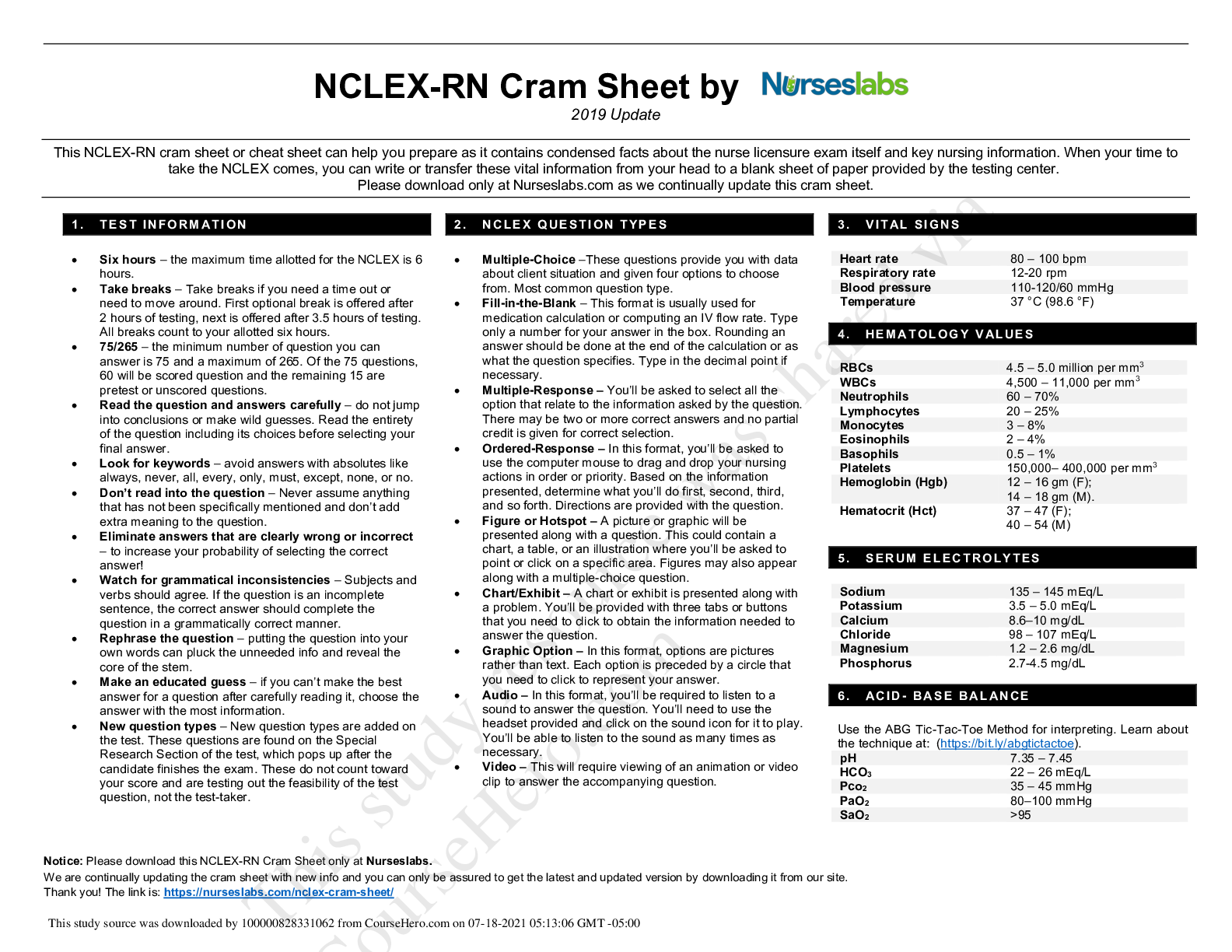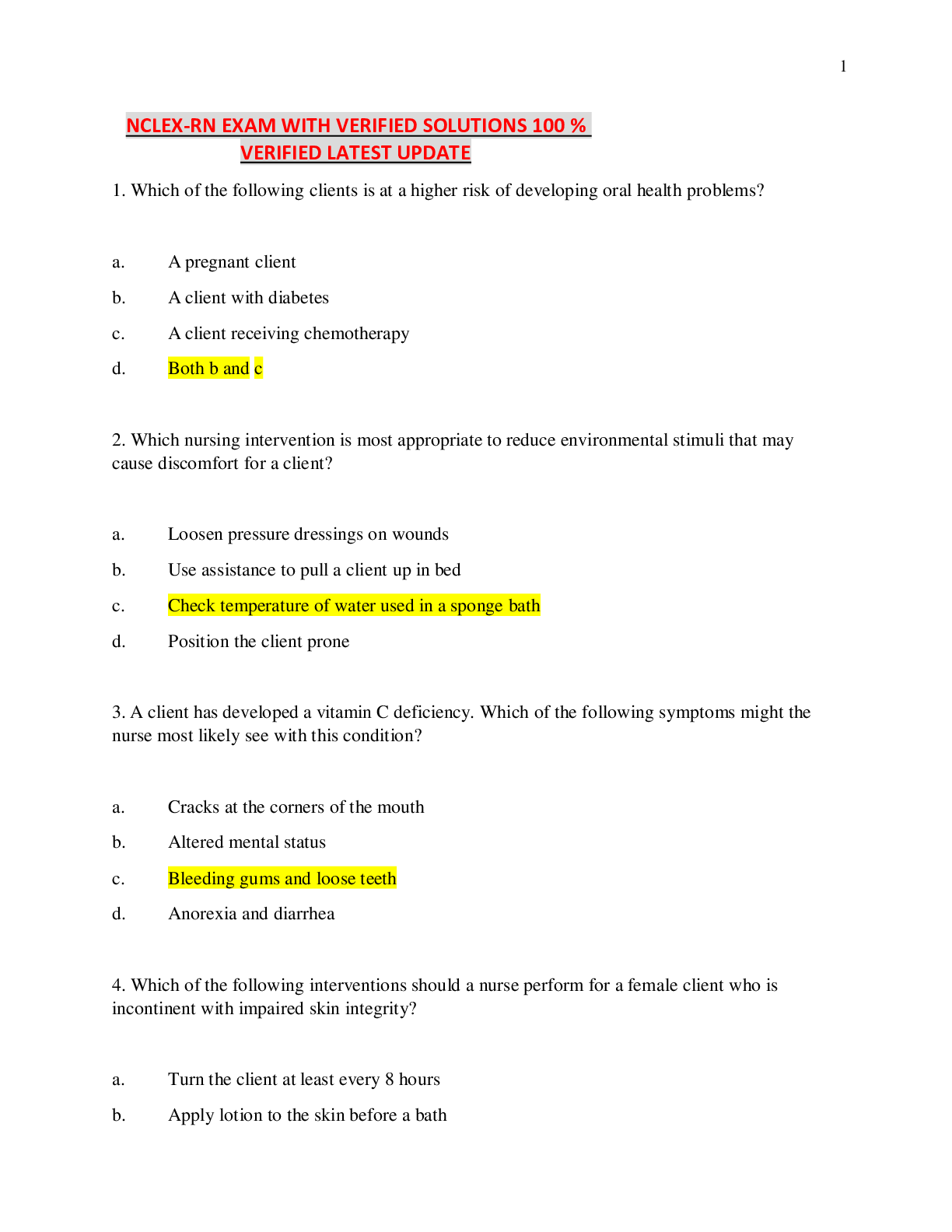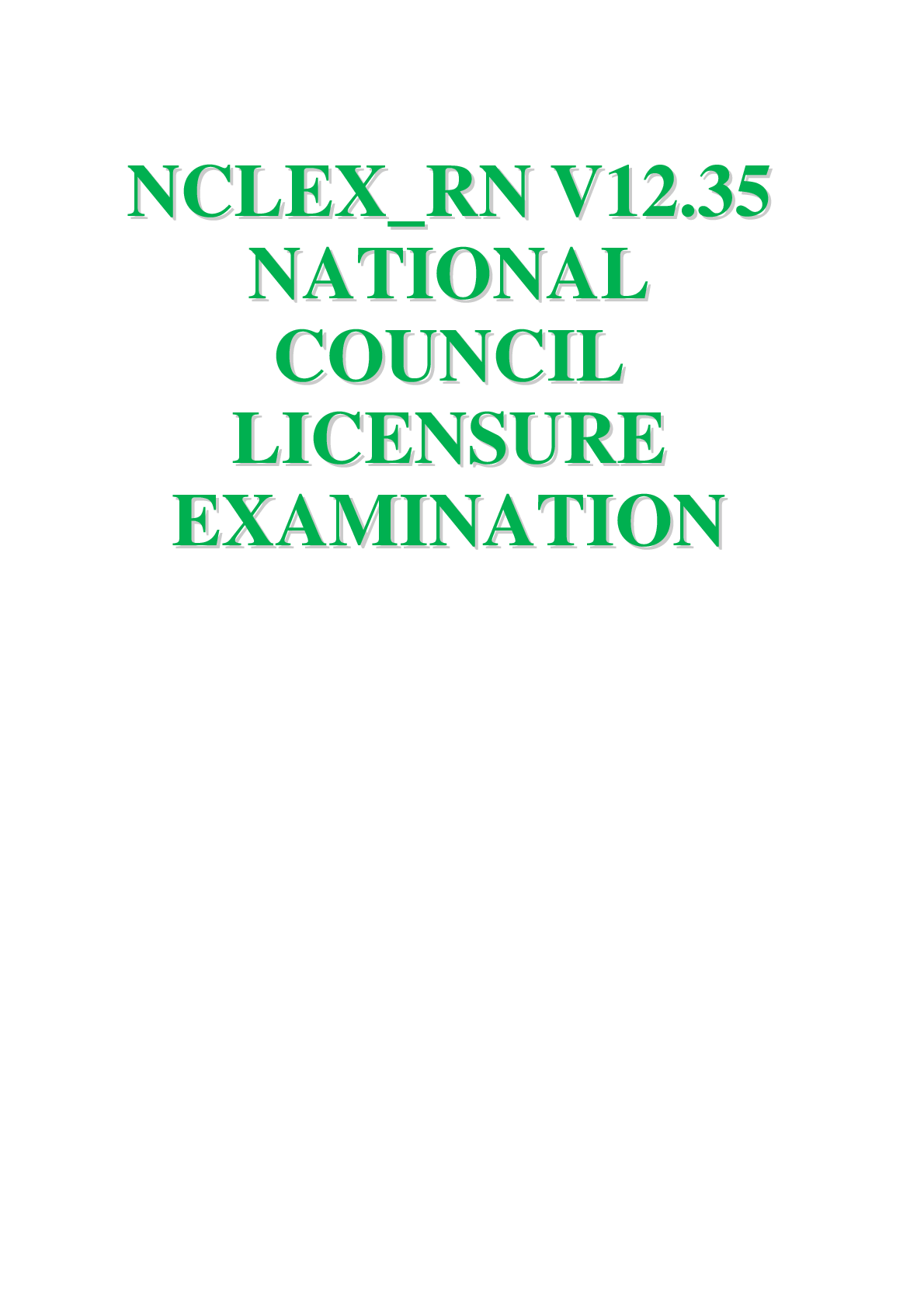*NURSING > NCLEX-RN > NURS 5603 _ ATI RN Adult MedSurg Online Practice B Questions And Answers/Rated A+/ Top Score (All)
NURS 5603 _ ATI RN Adult MedSurg Online Practice B Questions And Answers/Rated A+/ Top Score
Document Content and Description Below
RN Adult Medical Surgical Online Practice 2019 B 1) A nurse is providing teaching to a client who has a severe form of stage II Lyme disease. Which of the following statements made by the client ref l... ects an understanding of the teaching? a. “I will need to take antibiotics for 1 year.” b. “My partner will need to take an antiviral medication.” c. “My joints ache because I have Lyme Disease.” d. “I bruise easily because I have Lyme Disease.” 2) A Nurse is caring for a client who is 4 hr postoperative following an open reduction internal fixation of the right ankle. Which of the following assessment findings should the nurse report to the provider? a. Extremity cool upon palpation b. Serosanguineous drainage on the dressing. c. Capillary refill of 2 seconds. d. Client report of discomfort when moving toes. 3) A nurse is assessing a client while suctioning the client’s tracheostomy tube. Which of the following findings should indicate to the nurse the client is experiencing hypoxia? a. The client starts to cough b. The client’s heart rate increases c. The client is diaphoretic d. The client’s blood pressure decreases 4) A nurse is caring for a client who is 8 hr postoperative following a total hip arthroplasty. The client is unable to void on the bedpan. Which of the following actions should the nurse take first? a. Document the client’s intake and output. b. Scan the bladder with a portable ultrasound. c. Pour warm water over the client’s perineum. d. Perform a straight catheterization. 5) A nurse is providing discharge instructions to a client who has active tuberculosis (TB). Which of the following information should the nurse include in the instructions? a. Sputum specimens are necessary every 2 to 4 weeks until there are three negative cultures. b. The contagious period generally lasts for 6 to 8 weeks after the initiation of medication therapy. c. Family members should follow airborne precautions at home. d. A follow-up tuberculosis 6) A nurse is caring for a client who has increased intracranial pressure (ICP) and is receiving mannitol via continuous IV infusion. Which of the following findings should the nurse report to the provider as an adverse effect of this medication? a. Decreased heart rate b. Crackles heard on auscultation c. Increased urinary output d. Decreased deep tendon reflexes 7) A nurse is providing discharge teaching to a client who is postoperative following a modified radical mastectomy. Which of the following instructions should the nurse include? a. Flex the affected arm when ambulating b. Numbness can occur along the inside of the affected arm c. Begin active range-of-motion exercises 1 day after surgery d. Dress in clothing that fits snugly 8) A nurse is providing education to a client who has tuberculosis (TB) and their family. Which of the following information should the nurse include in the teaching? a. After 1 week of medication, TB is no longer communicable. b. Dispose of contaminated tissues in a paper bag. c. Airborne precautions are necessary in the home. d. Family members in the household should undergo TB testing. 9) A nurse is providing discharge teaching about infection prevention to a client who has AIDS. Which of the following statements by the client indicates understanding of the teaching? a. “I will eat a salad at least once each day to increase my intake of vitamin K.” b. “I can work in my flower garden as long as I wear gardening gloves to cover my skin.” c. “I will no longer floss my teeth after brushing my teeth.” d. “I can sip on a glass of juice for at least 2 hours before I should discard it.” 10) A nurse is assessing a client who is at risk for the development of pernicious anemia resulting from peptic ulcer disease. Which of the following images depicts a condition caused by pernicious anemia? a. 11) A nurse is reviewing the laboratory results of a client who has aplastic anemia. Which of the following findings indicates a potential complication? a. RBC count 5.2 million/mm3 b. WBC count 2,000/mm3 c. Platelets 380,000/mm3 d. Potassium 4 mEq/L 12) A nurse is assessing heart sounds of a client who reports substernal precordial pain. Identify which of the following sounds the nurse should document in the client’s medical record by listening to the audio clip. a. Murmur b. S4 c. Pericardial friction rub d. Ventricular gallop 13) A nurse is admitting a client who has active tuberculosis. Which of the following types of transmission precautions should the nurse initiate? a. Airborne b. Droplet c. Contact d. Protective environment 14) A nurse is preparing to present a program about prevention of atherosclerosis at a health fair. Which of the following recommendations should the nurse plant to include? (select all that apply) a. Follow a smoking cessation program b. Maintain an appropriate weight c. Eat a low-fat diet d. Increase fluid intake e. Decrease intake of complex carbohydrates 15) A home health nurse is providing teaching to a client who has a stage 1 pressure injury on the greater trochanter of his left hip. Which of the following instructions should the nurse include in the teaching? a. Clean the wound daily with an antiseptic b. Use a donut-shaped pillow when sitting in a chair c. Change position every hour d. Massage the area two times daily 16) A nurse is providing teaching to a client who takes ginkgo biloba as an herbal supplement. Which of the following statements should the nurse make? a. “Ginkgo biloba relieves nausea for people who have vertigo.” b. “Taking ginkgo biloba will help relieve your joint pain.” c. “Ginkgo biloba can cause an increased risk for bleeding.” d. “Taking ginkgo biloba decreases the risk of migraine headache.” 17) A nurse is providing teaching to a client who has a new prescription for psyllium. Which of the following information should the nurse include in the teaching? a. Drink 240 mL (8 oz) of water after administration. b. Expect results in 4 to 6 hr c. Take this medication before meals to increase appetite. d. Reduce dietary fiber intake to improve medication absorption. 18) A nurse is assessing a client who has advanced lung cancer and is receiving palliative care. The client has just undergone thoracentesis. The nurse should expect a reduction in which of the following common manifestations of advanced cancer? a. Dyspnea b. Hemoptysis c. Mucus production d. Dysphagia 19) A nurse is caring for a client who is receiving mechanical ventilation via a tracheostomy tube. The nurse should recognize that which of the following complications is associated with long-term mechanical ventilation? a. Elevated blood pressure b. Dehydration c. Stress ulcers d. Hypernatremia 20) A nurse is assessing a client who is postoperative following a thyroidectomy. Which of the following findings is the nurse’s priority? a. Moderate serosanguinous drainage on the dressing b. Calcium 9.5 mg/dL c. Temperature 38.9C (102F) d. Decreased bowel sounds 21) A nurse is teaching a family about the care of a parent who has a new diagnosis of Alzheimer’s disease. Which of the following information should the nurse include in the teaching? a. Position tabletop clocks with multi-colored backgrounds throughout the home. b. Explain how to complete a task while having the client do the task. c. Place a calendar on the wall with days and weeks included. d. Create complete outfits and allow the client to select one each day. 22) A nurse on a medical-surgical unit is reviewing the medical record of an older adult client who is receiving IV fluid therapy. Which of the following client information should indicate to the nurse that the client requires re-evaluation of the IV therapy prescription? a. Blood pressure (118/68) b. Prescribed medications (propranolol, metformin, alendronate sodium) c. Oxygen saturation (96%) d. BUN (29 mg/dL) 23) A nurse is providing preoperative teaching for a client who is scheduled for a mastectomy. Which of the following statements should the nurse make? a. “You should accept your body image change before discharge.” b. “It is important for you to look at the incisional site when the dressings are removed.” c. “I will refer you to community resources that can provide support.” d. “The scar will remain red and raised for many years after surgery.” 24) A nurse is caring for a client following extubating of an endotracheal tube 10 min ago. Which of the following findings should the nurse report to the provider immediately? a. Stridor b. Oral secretions c. Hoarseness d. Sore throat 25) A nurse is assessing a client who has diabetes insipidus. Which of the following findings should the nurse expect? a. Low urine specific gravity b. Hypertension c. Bounding peripheral pulses d. Hyperglycemia 26) A nurse is assessing a client who is postoperative following a transurethral resection of the prostate (TURP) and notes clots in the client’s indwelling urinary catheter and a decrease in urinary output. Which of the following actions should the nurse take? a. Remove the client’s indwelling urinary catheter b. Irrigate the indwelling urinary catheter c. Clamp the indwelling urinary catheter d. Apply traction to the indwelling urinary catheter 27) A nurse is caring for a client who has an arterial line. Which of the following actions should the nurse take? a. Flush the line before administering antibiotics b. Position the client in Trendelenburg to obtain measurements c. Have the client bear down when readings are obtained d. Place a pressure bag around the flush solution 28) A nurse is planning a health promotional presentation for a group of African American clients at a community center. Which of the following disorders presents the greatest risk to this group of clients? a. Multiple sclerosis b. Skin cancer c. Urolithiasis d. Hypertension 29) A nurse is caring for an older adult client who has dementia and requires acute care for a respiratory infection. The client is agitated and is attempting to remove their IV catheter. Which of the following actions should nurse take to avoid restraining the client? a. Check on the client every 2 hr b. Provide a quiet environment with no distractions c. Turn on the television in the client’s room d. Keep the client occupied with a manual activity 30) A nurse is planning discharge teaching for a client who has an external fixation device for a fracture of the lower extremity. Which of the following instructions should the nurse include in the plan of care? a. Secure the straps firmly around the boot b. Remove the device before showering c. Use crutches with rubber tips d. Adjust the screws to maintain alignment 31) A nurse is assessing a client who has peripheral arterial disease. Which of the following findings should the nurse expect? a. Painless ulcerations on the ankles b. Hair loss on the lower legs c. No extremity pain when resting d. Rubor with elevation of the extremity 32) A nurse is reviewing the medical record of a client who is taking warfarin for chronic atrial fibrillation. Which of the following values should the nurse identify as a desired outcome for this therapy? a. INR 1 b. INR 2.5 c. aPTT 45 seconds d. aPTT 90 seconds 33) A nurse is reviewing the medical record of a client who has osteomyelitis and a prescription for gentamicin. Which of the following findings from the client’s medical record should indicate to the nurse the need to withhold the medication and notify the provider? a. WBC count (13,700/mm3) b. Temperature (38.4C/101.4F) c. Blood pressure (155/98 mm Hg) d. Serum creatinine (2.1 mg/dL) 34) A nurse is providing teaching to a client who has anemia and a new prescription for an oral iron supplement. Which of the following statements by the client indicates an understanding of the teaching? a. “I will take my iron with a glass of milk.” b. “I will take an antacid with my iron.” c. “I will limit my intake of red meat.” d. “I will eat more high-fiber foods.” 35) A nurse is caring for a client who has a cervical spinal cord injury sustained 1 month ago. Which of the following manifestations indicates that the client is experiencing autonomic dysreflexia (AD)? a. Temperature 38.9C (102F) b. Systolic blood pressure 70 mm Hg c. Heart rate 52/min d. Respiratory rate 8/min 36) A nurse is caring for a newly admitted client who has a gastric hemorrhage and is going into shock. Identify the sequence of actions the nurse should take. Move the steps into the right order. a. Administer oxygen via a nonrebreather mask b. Initiate IV therapy with a large-bore catheter c. Insert an NG tube d. Administer ranitidine 37) A nurse is planning care for a client who is scheduled for a thoracentesis. Which of the following interventions should the nurse include in the plan? a. Encourage the client to take deep breaths after the procedure. b. Assist the client to hold their arms up during the procedure c. Instruct the client to remain NPO after midnight prior to the procedure d. Keep the client on bed rest for 8 hr following the procedure. 38) A nurse is updating the plan of care for a client who is receiving chemotherapy. Which of the following findings should the nurse identify as the priority? a. Report of sore throat b. Report of memory loss c. Alopecia d. Mucositis 39) A nurse is providing follow-up care for a client who sustained a compound fracture 3 weeks ago. The nurse should recognize that an unexpected finding for which of the following laboratory values is manifestation of osteomyelitis and should be reported to the provider? a. Sedimentation rate b. Hematocrit c. Calcium d. Acid phosphatase 40) A nurse is caring for a client who had a nephrostomy tube inserted 12 hr ago. Which of the following findings should the nurse report to the provider? a. The client’s urinary output has increased b. The client reports back pain c. The client’ urine color is red tinged d. The client’s BUN is 18 mg/dL 41) A nurse is providing teaching to a client who has a recent diagnosis of constipationpredominant irritable bowel syndrome. Which of the following instructions should the nurse include in the teaching? a. Take a calcium antacid before meals and at bedtime b. Consume at least 30 g of fiber daily c. Take a stimulant laxative daily d. Consume no more than 1,000 mL of water per day 42) A nurse is planning care for an older adult client who has dementia. Which of the following interventions should the nurse include in the plan of care? a. Explain procedures as they occur to the client b. Place personal items, such as pictures, at the client’s bedside c. Orient the client to their location once a shift d. Encourage the family members to remain home until the client has adjusted. 43) A nurse is planning care for a client who is postoperative following a parathyroidectomy. Which of the following actions should the nurse identify as the priority? a. Use pillows to support the client’s head and neck b. Offer opioid medication c. Place a tracheostomy tray at the bedside d. Place the client in semi-fowler’s position 44) A nurse is assessing a client following the completion of hemodialysis. Which of the following findings is the nurse’s priority to report to the provider? a. Temperature 37.2C (99F) b. Blood pressure 100/70 mm Hg c. Weight loss d. Restlessness 45) A nurse is administering packed RBCs to a client. Which of the following assessment findings indicates a hemolytic transfusion reaction? a. Anorexia and jaundice b. Bronchospasm and urticaria c. Hypertension and bounding pulse d. Low back pain and apprehension 46) A nurse is planning care for a client who is having a modified radical mastectomy of the right breast. Which of the following interventions should the nurse include in the plan of care? a. Instruct the client that the drain will be removed when there is a 25 mL of output or less over a 24-hr period. b. Assist the client to start arm exercises 48 hr after surgery c. Maintain the right arm in an extended position at the client’s side when in bed d. Place the client in a supine position for the first 24 hr after surgery 47) A nurse is providing teaching to a client who has AIDS. Which of the following statements by the client indicates an understanding of the teaching? a. “I should clean my toothbrush in the dishwasher once a month.” b. “I should eat more fresh fruit and vegetables.” c. “I will avoid drinking a glass of cold liquid that has been standing for 30 minutes.” d. “I will take my temperature once a day.” 48) A nurse is reviewing the laboratory findings of a client who developed chest pain 6 hr ago. The nurse should identify which of the following findings as an indication of a myocardial infarction (MI)? a. Creatine kinase (CK-MB) 85 units/L b. High-density lipoprotein (HDL) 65 mg/dL c. Alanine aminotransferase (ALT) 28 units/L d. Troponin I 8 ng/mL 49) A nurse is teaching a client about osteoporosis prevention. The nurse should instruct the client that which of the following medications can increase their risk for developing osteoporosis? a. Conjugated estrogens b. Enalapril c. Prednisone d. Colchicine 50) A nurse is preparing to administer phenytoin 600 mg PO daily to a client. The amount available is oral solution 125 mg/5 mL. How many mL should the nurse administer? a. 24 mL 51) A nurse at an urgent care clinical is caring for a client who is experiencing an anaphylactic reaction. After ensuring a patent airway, which of the following nursing interventions is the priority? a. Applying oxygen via face mask b. Placing the client in Fowler’s position c. Administering epinephrine d. Initiating an IV infusion of 0.9% sodium chloride 52) A nurse is preparing to administer a blood transfusion to a client who has anemia. Which of the following actions should the nurse take first? a. Obtain the client’s vital signs b. Describe the blood transfusion procedure to the client c. Check for the type and number of units of blood to administer d. Initiate a peripheral IV line 53) A nurse is planning care for a client who has a sealed radiation implant for cervical cancer. Which of the following interventions should the nurse include in the plan of care? a. Keep a lead-lined container in the client’s room b. Limit each visitor to 1 hr per day c. Place a dosimeter badge on the client d. Remove soiled linens form the client’s room each day. 54) A nurse is caring for a client who has breast cancer and tells the nurse that they would like to acupuncture because it provides greater relief than pain medication. Which of the following statements should the nurse make? a. “acupuncture is not an approved treatment for cancer pain.” b. “I can speak to the provider about incorporating acupuncture into your treatment plan.” c. “I will ask the provider to prescribe a stronger medication to help ease your pain.” d. “I can contact a family member or spiritual advisor for you to speak with.” 55) A nurse is caring for a client who is receiving total parenteral nutrition (TPN) and is NPO. When reviewing the chart, the nurse notes the following prescription: capillary blood glucose AC and HS. Which of the following actions should the nurse take? a. Check the client’s blood glucose according to facility mealtimes b. Contact the provider to clarify the prescription c. Request for meals to be provided for the client d. Hold the prescription until the client is no longer NPO 56) A nurse is caring for a client who has a positive culture for methicillin-resistant Staphylococcus aureus (MRSA). Which of the following actions should the nurse take? a. Obtain a sputum specimen to determine if there is colonization b. Bathe the client using chlorhexidine solution c. Place the client in droplet isolation d. Restrict visits from the client’s friends and family 57) A nurse is caring for a client who has pneumothorax and a closed-chest drainage system. Which of the following findings is an indication of lung re-expansion? a. The chest tube is draining serosanguineous fluid at 65 mL/hr b. The client tolerates gentle milking of the tubing c. Bubbling in the water seal chamber has ceased d. There is tidaling in the water seal chamber 58) A nurse is providing teaching to a client who has asthma about the use of metered-dose inhaler. The nurse should identify that which of the following client actions indicates an understanding of the teaching? a. Breathing in rapidly while administering the medication b. Washing the plastic case and cap of the inhaler in the dishwasher c. Holding breath for 10 seconds after inhaling d. Waiting 15 seconds between puffs, if two puffs are required 59) A nurse is caring for a client who has diabetic ketoacidosis (DKA). Which of the following should the nurse plan to administer? a. 240 mL (8oz) of orange juice b. 1 ampule of 50% dextrose IV bolus c. NPH insulin 60 units subcutaneous d. Regular insulin 20 units IV bolus 60) A nurse is providing education to a client who is at risk for osteoporosis. Which of the following instructions should the nurse include? a. Begin taking glucosamine supplements b. Walk for 30 min four times per week c. Jog for 15 min two times per week d. Avoid taking over-the-counter calcium supplements 61) A nurse is providing teaching to a client who has hypertension and a new prescription for verapamil. Which of the following information should the nurse include in the teaching? a. “Take this medication on an empty stomach.” b. “Eczema is an immediate expected adverse effect of this medication.” c. “Increase fiber intake to avoid constipation.” d. “Monitor your blood pressure monthly.” 62) A nurse is obtaining a medication history from a client who is scheduled to undergo cataract surgery. The nurse should recognize that which of the following client medications is a contraindication for the surgery and notify the provider? a. Hydrocodone b. Bupropion c. Lactulose d. Warfarin 63) A nurse is assessing a client’s hydration status. Which of the following findings indicates fluid volume overload? a. Warm, moist skin b. Distended neck veins c. Dark amber, odiferous urine d. Orthostatic hypotension 64) A nurse is providing postoperative teaching for a client who had a total knee arthroplasty. Which of the following instructions should the nurse include? a. Flex the foot every hour when awake. b. Place a pillow under the knee when lying in bed c. Lower the leg when sitting in a chair d. Ensure the leg is abducted when resting in bed 65) A nurse is receiving report on a client who is postoperative following an open repair of Zenker’s diverticulum. The nurse should anticipate the surgical incision to be in which of the following locations? a. A 66) A nurse is checking the ECG rhythm strip for a client who has a temporary pacemaker. The nurse notes a pacemaker artifact followed by a QRS complex. Which of the following actions should the nurse take? a. Document that depolarization has occurred b. Increase the pacemaker’s voltage c. Decrease the pacemaker’s sensitivity d. Check the placement of the ECG leads 67) A nurse is reviewing the laboratory results of a client who has AIDS and is taking amphotericin B for a fungal infection. The nurse should identify that which of the following values is an indication of an adverse effect of the medication? a. Potassium 4.8 mEq/L b. Magnesium 1.7 mEq/L c. BUN 34 mg/dL d. Hematocrit 45% 68) A nurse is providing teaching to a client who has end-stage kidney disease and is waiting for a kidney transplant. Which of the following information should the nurse provide? a. Kidney donation must come from a living donor b. Immunosuppressive therapy is necessary until the donated kidney begins producing urine c. Hemodialysis is sometimes required following surgery d. Kidney transplant recipients can resume their regular diet following surgery 69) A nurse is providing teaching to a client who is perimenopausal and has a prescription for hormone replacement therapy. For which of the following adverse effects should the nurse instruct the client to notify the provider (select all that apply)? a. Night sweats b. Calf pain c. Vaginal dryness d. Numbness in the arms e. Intense headache 70) A nurse is caring for a client who has terminal cancer. The client tells the nurse, “I wish I could stop these treatments. I am ready to die.” Which of the following statements should the nurse make? a. “Discontinuing with the treatments is your choice if it is your wish to do so.” b. “Your daughter is named as your health care surrogate. I will ask her if you can stop them.” c. “I will call your spiritual advisor to come in, so you can discuss this with them.” d. “Next time you have an oncology appointment, you should ask the oncologist.” 71) A nurse is caring for a client who is having a tonic-clonic seizure while in bed and has become cyanotic. Which of the following actions should the nurse take? (select all that apply). a. Restrain the client b. Prepare to suction the client’s airway c. Insert a tongue blade in the client’s mouth d. Raise the head of the client’s bed to a semi-fowler’s position e. Loosen restrictive clothing on the client 72) A nurse is caring for a client who is receiving a blood transfusion. The client becomes restless, dyspneic, and has crackles noted to the lung bases. Which of the following actions should the nurse anticipate taking? a. Administer an antihistamine b. Slow the infusion rate c. Give the client a corticosteroid d. Elevate the client’s lower extremities 73) A nurse is performing a preoperative assessment for a client. The nurse should identify that an allergy to which of the following foods can indicate a latex allergy? a. Shellfish b. Peanuts c. Avocados d. Eggs 74) A nurse is evaluating the plan of care for four client’s after 2 days of hospitalization. The nurse should identify the need to revise the plan for which of the following clients? a. A client who is taking potassium supplements, has a potassium level of 3.2 mEq/L and reports constipation. b. A client who ahs Alzheimer’s Disease (AD), has a room near the nurse’s station, and is agitated c. A client who is postoperative following abdominal surgery and reports feeling that something “popped” when they coughed d. A client who has a conductive hearing loss, speaks softly, and is scheduled for a cerumen removal 75) A nurse is reviewing the ABG results of a client who has advanced COPD. Which of the following results should the nurse expect? a. PaCO2 56 mm Hg b. pH 7.38 c. HCO3- 24 mEq/L d. PaO2 90 mm Hg 76) A nurse is teaching a client about the use of transcutaneous electrical nerve stimulation (TENS) for the management of bone cancer pain. The nurse should explain that applying a TENS unit to the painful area has which of the following effects? a. Electrically generated feelings of heat b. Cryotherapy of painful areas c. A tingling sensation replacing the pain d. Realignment of energy flow through meridians 77) A nurse is teaching a group of newly licensed nurses about pain management for older adult clients. Which of the following statements by a newly licensed nurse indicates an understanding of the teaching? a. “Older adult clients might require up to 6 grams of acetaminophen over 24 hours for effective pain control.” b. “Ibuprofen can cause gastrointestinal bleeding in older adult clients.” c. “Meperidine is the medication of choice for older adult clients experiencing severe pain.” d. “Older adult clients taking oxycodone are at risk for diarrhea.” 78) A nurse in an emergency department is assessing an older adult client who has a fractured wrist following a fall. During the assessment, the client states, “Last week I crashed my car because my vision suddenly became blurry.” Which of the following actions is the nurse’s priority? a. Check the client’s neurological status b. Document the client’s statements c. Prepare the client for a CT scan d. Teach the client about using safety precautions for falls 79) A nurse is teaching a client who has a cardiac dysrhythmia about the purpose of undergoing continuous telemetry monitoring. Which of the following statements by the client reflects an understanding of the teaching? a. “This measures how much blood my heart is pumping.” b. “This identifies if I have a defective heart valve.” c. “This identifies if the pacemaker cells of my heart are working properly.” d. “This measures the blood circulating to my heart muscle.” 80) A nurse is providing teaching to a client who has stage II cancer and is scheduled for brachytherapy. Which of the following instructions should the nurse include? a. “You will have an implant placed twice each month for the duration of the treatment.” b. “You should remain at least 6 feet away from others between treatments.” c. “You should expect to have blood in your urine for a few days after treatment.” d. “You will need to stay still in the bed during each treatment session.” 81) A nurse is caring for a client who has DKA. Which of the following findings should indicate to the nurse that the client’s condition is improving? a. Potassium 3.5 mEq/L b. pH 7.28 c. Glucose 272 mg/dL d. HCO3- 14 mEq/L 82) A nurse is providing discharge instructions to a client who has laryngeal cancer and is receiving radiation therapy. Which of the following statements by the client indicates an understanding of the teaching? a. “I will wear a badge to measure how much radiation I am receiving.” b. “I will remove the markings on my skin after each radiation treatment.” c. “I will avoid direct exposure to the sun.” d. “I will rinse my mouth with a commercial mouthwash.” 83) A nurse is providing discharge teaching to a client who is to self-administer heparin subcutaneously. Which of the following statements by the client indicates an understanding of the teaching? a. “I can expect to have blood in my urine during the first week of injections.” b. “I will floss my teeth after each meal.” c. “I will gently massage the site after I inject my medication.” d. “I will use an electric razor to shave.” 84) A PACU nurse is assessing a client who is postoperative following a right nephrectomy. The client’s initial vital signs were heart rate 80/min, blood pressure 130/70 mm Hg, respiratory rate 16/min, and temperature 36C (96.8F). Which of the following vital signs changes should alert the nurse that the client might be hemorrhaging? a. Heart rate 110/min b. Blood pressure 160/70 mm Hg c. Respiratory rate 14/min d. Temperature 38.4C (101.1F) 85) A nurse is caring for a client who has hypothyroidism. Which of the following manifestations should the nurse expect? a. Constipation b. Insomnia c. Tachycardia d. Diaphoresis 86) A nurse is assessing for compartment syndrome in a client who has a short leg cast. Which of the following findings should the nurse identify as a manifestation of this condition? a. Bounding pedal pulses b. Capillary refill less than 2 seconds c. Pain that increases with passive movement d. Areas of warmth on the cast 87) A nurse is caring for a client who has homonymous hemianopsia as a result of a stroke. To reduce the risk of falls when ambulating, the nurse should provide which of the following instructions to the client? a. “Wear an eye patch over one eye.” b. “Make sure to have a staff member walk on your stronger side.” c. “Scan the environment by turning your head from side to side.” d. “Make sure to look at your feet while walking.” 88) A nurse is planning care for a client who is postoperative following a laparotomy and has a closed-suction drain. Which of the following actions should the nurse take to manage the drain? a. Set the wall suction to 80 to 100 mm Hg. b. Compress the drain reservoir after emptying c. Allow the drainage to collect on a sterile gauze dressing d. Position the drain below the bed to promote drainage 89) A nurse is reviewing the medical record of a client who has systemic lupus erythematosus (SLE). Which of the following findings should the nurse expect? a. Facial butterfly rash b. Bradycardia c. Esophagitis d. Interstitial fibrosis 90) A nurse is assessing a client who has a diagnosis of rheumatoid arthritis. Which of the following nonpharmacological interventions should the nurse suggest to the client to reduce pain? a. Increase intake of foods containing calcium b. Alternate application of heat and cold to the affected joints c. Keep the affected extremities elevated d. Limit movement of the affected joints 91) A nurse is admitting a client who has meningitis. Which of the following actions should the nurse take? a. Place the client on seizure precautions b. Position the client’s head of bed flat c. Check the client’s neurologic status every 8 hr d. Initiate contact precautions for the client 92) [Show More]
Last updated: 1 year ago
Preview 1 out of 16 pages
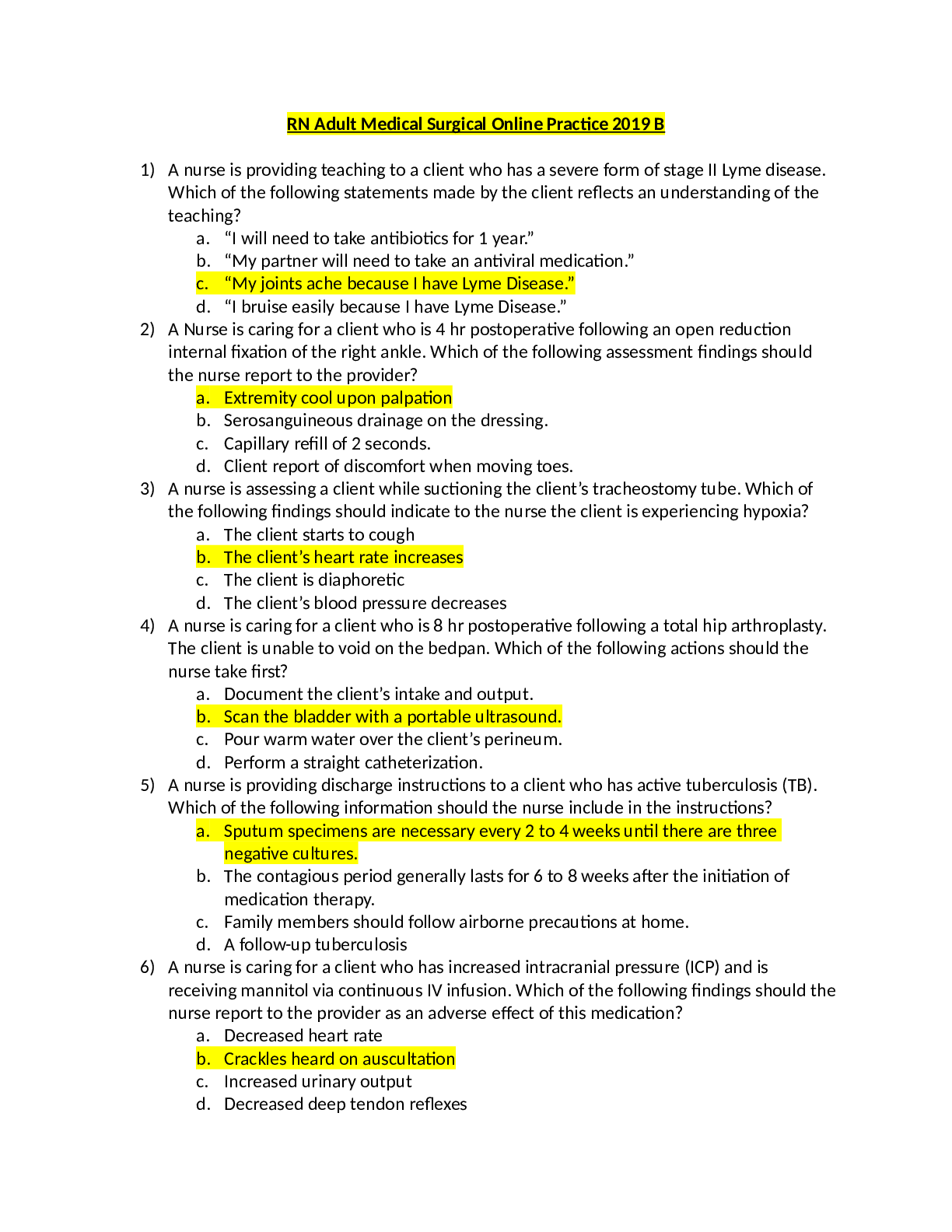
Reviews( 0 )
Document information
Connected school, study & course
About the document
Uploaded On
Feb 25, 2022
Number of pages
16
Written in
Additional information
This document has been written for:
Uploaded
Feb 25, 2022
Downloads
0
Views
68




